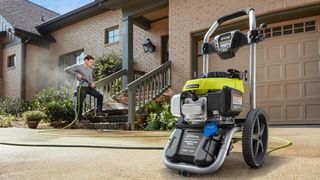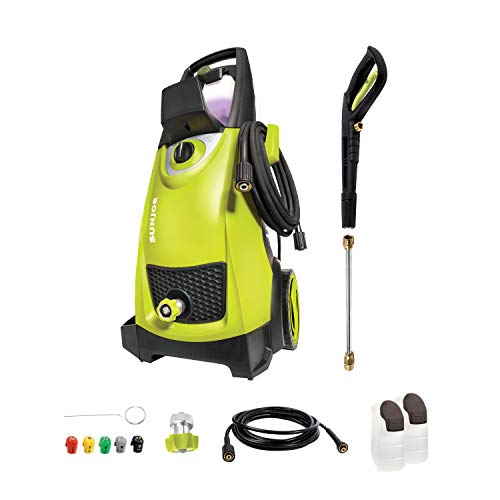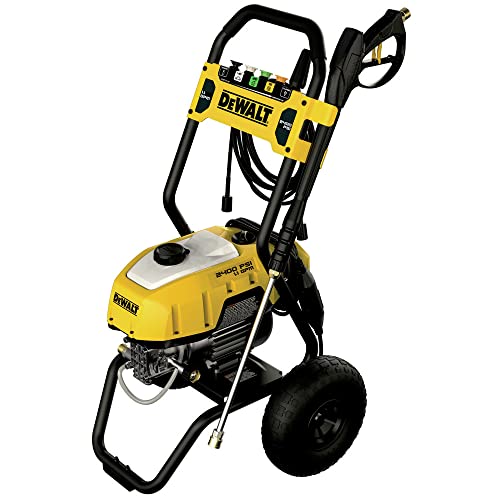The best pressure washers work by spraying water at high pressure to blast off layers of dirt and grime and reveal the clean surface underneath so it looks as good as new. They’re a fast, convenient way to get your yard looking pristine, no scrubbing required. The first choice you’ll need to make is between a gas-powered pressure washer and an electric one. The difference? A gas pressure washer boasts maximum power, while electric models are kinder to the planet plus are quieter and more convenient to maintain. So what do you need to consider when selecting the best pressure washer for you? Power is an important factor and you’ll find this is measured in pounds per square inch (PSI). The most powerful models tend to be more expensive so you’ll have to judge what’s right for you. Our round-up includes the best pressure washers for a range of budgets so there’s plenty to choose from. If you’re concerned about reliability, you’ll be relieved to know that most of our picks of the best pressure washers offer a decent warranty to put your mind at rest. You’ll find some models that come with additional features like a range of different nozzles so you can customize the pressure washer for the surface you’re tackling. Once your yard is sparkling clean, you may want to neaten up the rest of your space. If so, check out our guides to the best gas lawn mowers (opens in new tab) and the best hedge trimmers (opens in new tab).
The best pressure washers to buy now
Our best overall choice provides power and high-end performance at a reasonable price. Similar powered pressure washers can cost up to $1,000 or more, but the Karcher K5 delivers similar results and is priced around the $300 mark. At 2000 PSI, the Karcher K5 is designed to tackle the toughest cleaning jobs around the home quickly, using 40 times the water pressure of a garden hose. Its water cooled induction motor ensures the unit does not overheat after hours of continuous cleaning, which is perfect for homeowners who have plenty of chores to do. It is also designed to prolong the life of the motor by up to 5x, making it a lot more reliable. The overall design is compact yet sturdy and easy to move around on the large 7.7” high impact wheels. It features a useful onboard detergent tank and two spray wands designed to meet your specific cleaning needs. It’s also one of the very few quiet pressure washers on the market. While it is built to last, you may find proprietary parts expensive if you do require any replacements. Nevertheless, the Karcher K5 packs a powerful punch for cleaning vehicles, fences, driveways and more, at a very reasonable price.
Read our Karcher K5 Premium review (opens in new tab)
The Simpson PowerShot PS4240 gas pressure washer is an extremely powerful commercial washer designed for heavy-duty cleaning tasks. Driven by its Honda GX390 premium gas engine and AAA industrial pump, this model cleans in a fraction of the time it would take with an electric washer. It is well built with premium features and, although it’s fairly heavy, it’s still easily portable. This may not be suitable for light-duty, domestic cleaning but contractors or professional services would benefit from the ease of use and tremendous power. A plus is that it is priced under $1,000, much cheaper than other professional washers. Which makes the Simpson PowerShot PS4240 outstanding value for money.
Read our Simpson PowerShot PS4240 review (opens in new tab)
If you just need something inexpensive and suitable for light-duty cleaning jobs, the Greenworks GPW1501 pressure washer is an excellent choice. Although small, it has adequate pressure for cleaning cars, patios and decking. The added bonus is that it’s one of the few washers available on the market for just under $100. It’s super lightweight and compact making it easy to carry around the home and neatly pack away. A drawback is that the hose can be a little stiff for unrolling but should loosen over time and more usage. This may not be powerful enough to do heavy-duty tasks like cleaning sidewalks or walls but is ideal for a starter pressure washer.
Read our Greenworks GPW1501 review (opens in new tab)
The Sun Joe SPX3000 pressure washer is an affordable electric model. It has been designed to tackle backyards, driveways, and cars, and while it’s not dirt cheap, it is far more affordable than some of the brand giants like Karcher. The Sun Joe pressure washer has dual detergent tanks - each of them allowing you to use the detergent most suited to the job you’re tackling. This pressure washer comes with a clean-out tool and five spray tips that make it easier to reach those trickier areas. What isn’t as great about the Sun Joe SPX3000 pressure washer is that it takes a while to assemble and for some, the electric cords may get in the way too.
Read our Sun Joe SPX3000 review (opens in new tab)
The RYOBI RY803001 was our best professional value choice for a gas pressure washer. While gas washers usually cost up to $1,000 or over, you can find a RYOBI 3000 for a fraction of the price at just $349. Driven by its powerful, Honda gas engine it quickly dealt with heavy duty grime in record time. Despite its weight, it’s easy to move around terrain on its sturdy track wheels. The fuel tank is a bit smaller than others, however the powerful engine handles cleaning jobs in half the time, so you won’t need to keep refueling. We chose this RYOBI pressure washer because we were impressed by its professional cleaning results at such a great value price point.
Read our RYOBI RY803001 3000-PSI Power Control review (opens in new tab)
The Stanley SLP 2050 2-In-1 is one of the most versatile pressure washers on the market. It is well engineered and durable and it’s unique 2-in-1 design means it can be used with the mobile cart or detached for use as a standalone unit. This makes it much more portable and handy for those light-to-medium cleaning jobs around the home and means it is light and compact enough to carry and store away. Considering its high-spec features and design, it’s reasonably priced. The Stanley SLP 2050 2-In-1 is ideal if you don’t have heavy-duty projects to tackle. One drawback is the pressure hose can be stiff and difficult to reel, but this should loosen in time.
Read our Stanley SLP 2050 2-In-1 review (opens in new tab)
This model delivers a decent power punch and scores well for aftercare options. It’s from a big brand, and the majority of users found it performed well for a domestic model. It delivers 2400 PSI and 1.1 GPM (gallons per minute) which isn’t as powerful as some comparable models but should still be enough for most domestic tasks. Features include a removable detergent tank so that you can easily refill, and a set of five interchangeable nozzles for different projects. This model features a 35-foot power cord and 25-foot kink-free hosepipe. At around $300, it’s towards the top end of the price bracket but offers an extensive warranty.
Read our DeWalt DWPW2400 pressure washer review (opens in new tab)
How we tested the best pressure washers
When it comes to performance, you can rest assured that we put the best pressure washers through their paces. We tried them out on two common jobs, cleaning driveways and vehicles. Scoring was based on the extent to which they delivered a thorough clean and how fast they worked. Our testers were tough to please with only the RYOBI RY14122 and the Craftsman CM1800 earning top marks. We wanted to make sure our picks could tackle the toughest of cleaning tasks so we designed our tests to be a real challenge. For the vehicle cleaning test, we drove a pickup through thick mud so that the wheel wells were fully caked. The test involved using the pressure washer to remove dried mud from half a wheel well. You’ll be pleased to know that all of our picks scrubbed up well and could handle cleaning a car or similar surface with ease. Next was the driveway challenge. We put the pressure washers to the test against a stubborn oil stain on a driveway. This was because our research had shown that oil is one of the hardest things to clean off a driveway, so if they could cope with that they would make light work of anything else. An impressive seven of the eight machines passed this test leaving no trace of the oil spot, though some did take longer to do so. The remaining machine, the WORX Hydroshot WG629, didn’t quite have the power to remove the oil spot.
How we tested pressure washer usability
To evaluate how easy a pressure washer is to use, our testers considered the following: Pressure wand and hose: The most impressive pressure washers had built-in wand storage, comfortable handles, and made it easy to swap nozzles and store hoses. Portability: Although a pressure washer’s weight affects portability, we noticed that portable pressure washers need high-quality wheels like those on the RYOBI RY14122, Craftsman CM1800 and Sun Joe SPX3000. Battery-powered units, like the WORX Hydroshot WG629, which we chose as the most portable unit in our comparison, can provide extra portability far from the nearest power outlet. Assembly: Generally speaking, units come mostly assembled, snap together without tools and can be used within minutes of opening the box. One pressure washer even came fully assembled in the box: The Craftsman CM1800. Although some units, such as the Sun Joe SPX3000, require a bit more work to assemble, the process takes 30 minutes or less. Power cord: With the exception of the battery-powered WORX Hydroshot WG629, every pressure washer we tested comes with a 35-foot power cord, which can be tedious to store if the machine doesn’t have hooks to secure it. We paid attention to this and scored accordingly. We ran each machine and placed a decibel meter one foot away to measure how loud it was. The quietest pressure washer we tested was the WORX Hydroshot WG629 at 79 dB. Two units tied for the loudest at 91 dB, the Greenworks GPW1501 and the Harbor Freight Portland 63254. Regardless of the machine, these results suggest you should use hearing protection every time you run a pressure washer.
What to look out for when buying a pressure washer
Pressure washer safety Before buying a pressure washer, you should be aware that they can cause serious injuries if used improperly. For this reason, you shouldn’t use the machine until you read the manual and are using proper safety equipment. Anderson says that Mi-T-M asks users to “follow all safety instructions on decals located on the washer and always wear safety goggles and closed toe shoes to protect yourself from the possibility of direct spray.” Regardless of safety equipment, keep the spray away from people and animals. With electric pressure washers, check that your power cord has a working ground fault circuit interrupter (GFCI) by hitting the “test” button before every use. While a GFCI can help prevent electrocution, you should keep water away from electrical cords and outlets as much as possible. Lastly, always turn the machine off and pull the trigger a few times to release any remaining pressure when you’re not actively using it, when switching nozzles or performing maintenance. Pressure and flow rate of pressure washers When buying a pressure washer, pay attention to the pressure rating, measured in pounds per square inch (PSI,) and the water flow rate, measured in gallons per minute (GPM.) In fact, you can get a quick idea of the cleaning power by multiplying PSI and GPM together to get what pressure washer manufacturers call cleaning units (CU.) While higher pressure and flow rate lead to more cleaning power, Anderson says “in most cases, a 2,000 PSI pressure washer will be sufficient for most homeowner cleaning tasks.” Likewise, our testing revealed that pressure washers with ratings as low as 1,500 PSI are good for most homeowners, though they can take longer to match the results of more powerful units. As such, you can expect to use most electric pressure washers for cleaning cars, wood decks, plastic patio furniture and concrete.
















